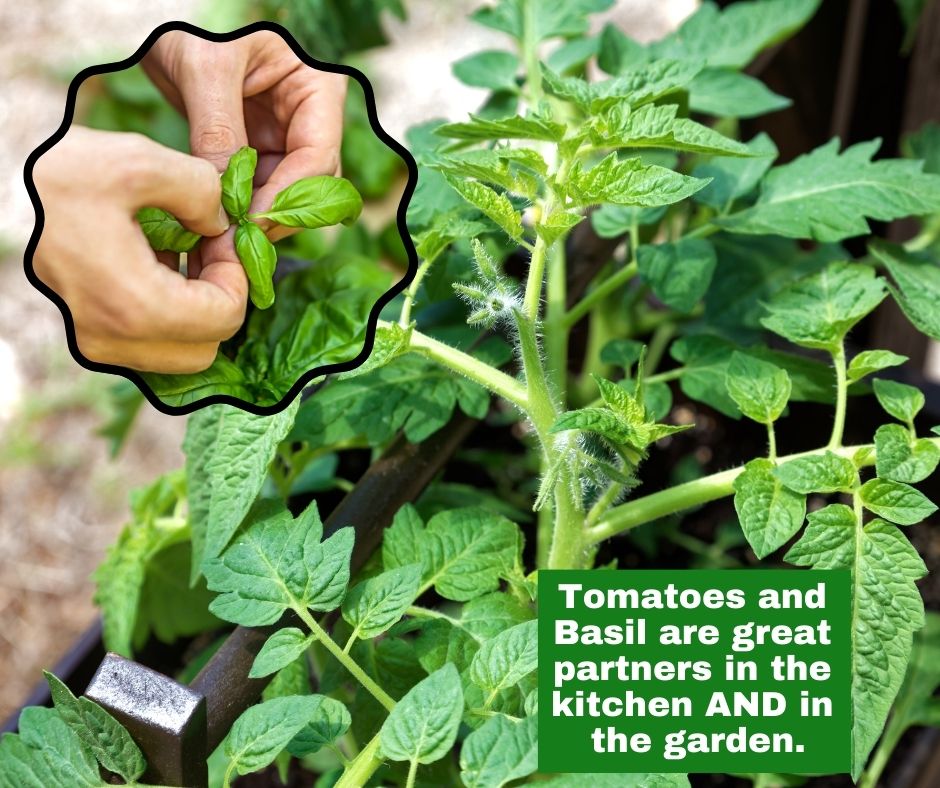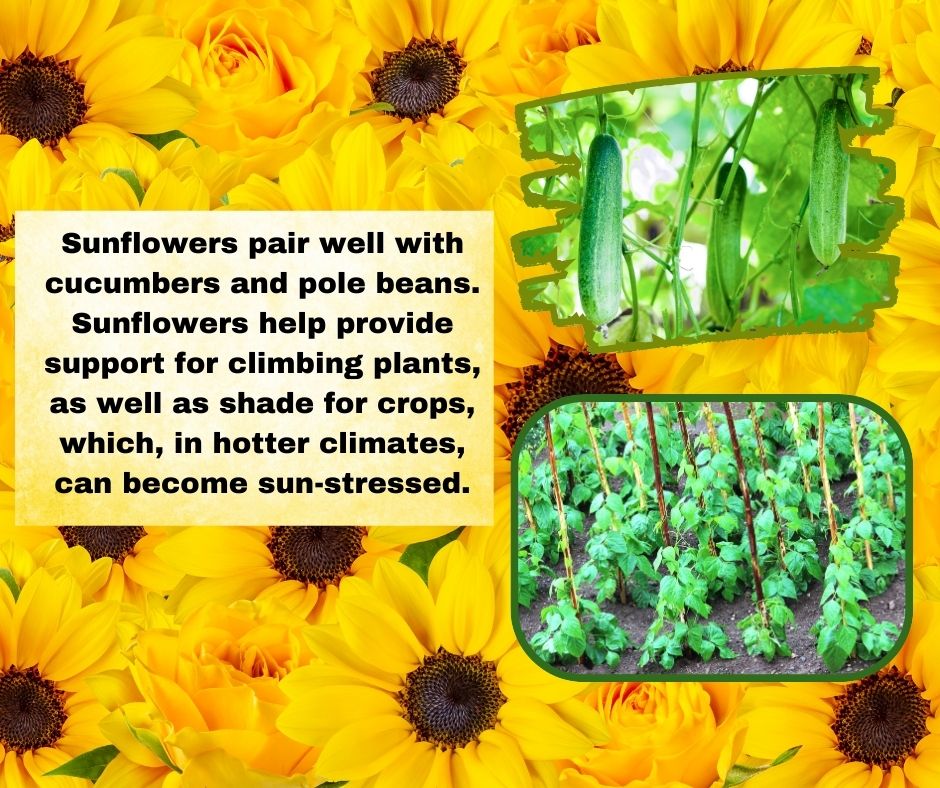Blog, Garden Blog, Garden Tips
What is Companion Planting . . . and why should you try it?
What is Companion Planting . . . and why should you try it?
Companion planting is when two plants are grown near each other to benefit one of those plants or both–so the benefit can be one way or mutual. This is a tried-and-tested way to reduce pests, attract pollinators, and boost growth! Here are common examples.
- Tomato and Basil are natural companions in the kitchen and garden. Basil repels certain insect pests such as thrips and also disorientates moths, which lay tomato hornworms.
- Aphids severely crimp your crop! But aphids can’t stand garlic! With this in mind, garlic planted as a barrier keeps crops less vulnerable to pest attack. For example, grow potatoes between rows of garlic to serve as a pungent bodyguard.
- Nasturtium flowers grown close to kale, cabbage, broccoli, and any brassica crops will lure hungry caterpillars away from eating your crops.

7 Benefits of Companion Planting
There are plenty more good reasons to plant certain crops together:
- Deterring pests: Certain plants act as insect repellents or deter critters. For example, garlic’s smell is unappealing to many pests.
- Attracting beneficials: Some plants also attract beneficial insects. For example, borage attracts pollinating bees and tiny pest-eating wasps.
- Shade regulation: Large plants provide shade for smaller plants needing sun protection. For example, corn shades lettuce.
- Natural supports: Tall plants, like corn and sunflowers, can support lower-growing, sprawling crops such as cucumbers and peas.
- Improved plant health: When one plant absorbs certain substances from the soil, it may change the soil biochemistry in favor of nearby plants.
- Improving soil fertility: Some crops, like beans, peas, and other legumes, help to make nitrogen more available in the soil. Similarly, plants with long taproots, like burdock, bring up nutrients from deep in the soil, enriching the topsoil to the benefit of shallow-rooted plants.
- Weed suppression: Planting sprawling crops like potatoes with tall, upright plants minimizes open areas, where weeds typically take hold.
Evidence-Based Companion Planting Philosophy
Until recently, a lot of companion planting was based on little more than hearsay, but there’s an increasing body of scientifically grounded research that actually proves that growing specific plants together can reduce pests, boost growth, and even help wildlife. We’ve collected it all and updated our companion planting chart below! Some background:
- Traditionally, it was thought that vegetables had “friends” and “foes”—companion plants that either benefitted the vegetables’ growth or impeded it. This isn’t necessarily wrong, but we’ve found that nearly all the associations are positive ones; there are perhaps 2 or 3 “bad” combinations (e.g., black walnut trees, which secrete growth inhibitors through their roots). Bottom-line: there is simply more evidence for “good” companions than “bad” ones, so we now focus more on why vegetables need friends!
- There are misconceptions about companion planting on the internet, which we found concerning. Many examples of companion planting were based folklore or hearsay. While observations in our own garden can be valuable, we decided that our reference guide should only highlight companion plant pairings backed up by scientific evidence and tried-and-true practices.
- While traditionally, companion planting referred to vegetable plant pairs, we’ve added more flowers to our chart; many are excellent natural insect repellents. Nasturtium is heads and shoulders above them all, taking the brunt of pest attacks. (See more below.) Of course, any nectar-rich flowers such as zinnia, comfrey and ageratum will attract pollinators such as bees to the garden, helping to boost the pollination of flowering crop plants like tomatoes, beans, and squash.
What are some of the best companion planting combinations?
- Basil and tomatoes as interplanted basil repels thrips, as mentioned above. Basil also deters the moths, which lay tomato hornworms and egg-laying armyworms. Basil also attracts bees, which improves pollination, tomato health, and flavor.
- Dill attracts ladybugs, which eat small garden pests such as aphids and spider mites.
- Borage pairs well with tomatoes, attracting pollinating bees. Borage also pairs well with strawberries, enhancing their flavor and vigor.
- Garlic and garlic spray have a strong scent that deters many insects. Aphids can’t stand garlic! Garlic also repels onion flies, ermine moths, and Japanese beetles. Plant garlic between rows of potatoes as well as alongside lettuces and cabbages and near fruit trees, together with alyssum, to attract aphid-eating hoverflies.
- Mint deters aphids, ants, and flea beetles. Just be careful to plant mint nearby in its own pot or bed, as it is a very aggressive grower!
- Nasturtiums attract hungry caterpillars away from brassicas like cabbage, broccoli, and kale, so grow these pretty flowers close to those crops; nasturtium also lure black flies away from fava beans.

- Parsley attracts beneficial insects to protect and pollinate tomatoes. Plant these herbs between tomatoes.
- Poached egg plants (a wildflower) draw in hoverflies, which control aphids on nearby lettuce.
- Sage is a useful herb that repels carrot flies. Also, plant it around a cabbage patch to reduce injury from cabbage moths.
- Sunflowers pair well with cucumbers and pole beans: Sunflowers help provide support for climbing plants, as well as shade for crops, which, in hotter climates, can become sun-stressed.
- Tansy is a real draw to pest-eating bugs such as ladybugs, ladybirds, and predatory wasps. At the same time, tansy repels many of the common baddies such as cutworm which attacks asparagus, bean, cabbage, carrot, celery, corn, lettuce, pea, pepper, potato, and tomato plants. Tansy is a perennial, which means you only have to plant it once.
More Companion Gardening Tips
Much of companion planting considers the height of different vegetables.
- Lettuce, radishes, and other quick-growing plants sown between hills of melons or winter squash will mature and be harvested long before these vines need more legroom.
- Leafy greens like spinach and Swiss chard will grow in the shadow of corn.
- Bush beans tolerate the dapple shade that corn casts and, since their roots occupy different levels in the soil, don’t compete for water and nutrients.
- Don’t get too fixated with pairing up crops. Correct spacing, sun, water, and good soil management are the most important influences on your growing.
- Why not start small with a few marigolds and zinnia seeds—and watch the beneficial bugs come! Other options to start with? How about calendula, nasturtium, basil, and borage? a garden flower?
For more plants, check out the online Almanac Garden Planner,
Learn More
- For ideas and inspiration, see readers’ companion garden plot plans with plant lists.
- Are you just getting started with gardening, or do you need a refresher course? Check out our Vegetable Gardening for Beginners how-to page.
- Need plant-specific growing advice? Read through our many Growing Guides for vegetables, fruit, flowers, and herbs.
Thanks to The Old Farmers Almanac for sharing their wisdom for this article. Check out their website for more information on this and a wide variety of other topics.

